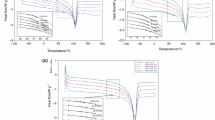Abstract
In this study, we investigated the viscoelastic and thermal properties of lignocellulosic material filled polypropylene (PP) bio-composites. Lignocellulosic fillers are totally bio-degradable and PP is a thermoplastic polymer which has good stiffness, tenacity, flexural strength and thermal properties. The thermal and viscoelastic properties of the composites with different filler contents were examined using differential scanning calorimetry (DSC) and dynamic mechanical thermal analysis (DMTA), respectively. The effects of the compatibilizing agent were also evaluated. The glass transition (T g ) and melting (T m ) temperatures of the composites did not vary significantly with the filler content, because no chemical bonding occurred at the interface between the matrix and filler. However, the compatibility between the filler and PP matrix was increased by the incorporation of the compatibilizing agent. The storage modulus (E′) of the composites was higher than that of the neat PP, indicating that the incorporation of the natural filler increased their stiffness. The thermal properties of the composites should be considered as an important factor in the manufacturing process and the use of the final products.







Similar content being viewed by others
References
Kim DY, Rhee YH. Biodegradation of microbial and synthetic polyesters by fungi. Appl Microbiol Biotechnol. 2003;61:300–8.
Kim HS, Yang HS, Kim HJ, Lee BJ, Hwang TS. Thermal properties of agro-flour-filled biodegradable polymer bio-composites. J Therm Anal Calorim. 2005;81:299–306.
Yang HS, Kim HJ, Park HJ, Lee BJ, Hwang TS. Water absorption behavior and mechanical properties of lignocellulosic filler-polyolefin bio-composites. Compos Struct. 2006;72:429–37.
Ichazo MN, Albano C, Gonzalez J, Perera R, Candal MV. Polypropylene/wood flour composites: treatments and properties. Compos Struct. 2001;54:207–14.
Yang HS, Kim HJ, Son J, Park HJ, Lee BJ, Hwang TS. Rice-husk filled polypropylene composites; mechanical and morphological study. Compos Struct. 2004;63:305–12.
Lee SY, Yang HS, Kim HJ, Jeong CS, Lim BS, Lee JN. Creep behavior and manufacturing parameters of wood flour filled polypropylene composites. Compos Struct. 2004;65:459–69.
Yang HS, Wolcott MP, Kim HS, Kim HJ. Thermal properties of lignocellulosic filler-thermoplastic polymer bio-composites. J Therm Anal Calorim. 2005;82:157–60.
Hatakeyama T, Liu Z. Handbook of thermal analysis. Beijing: Chemical Industry Inc; 1994. p. 13.
Ganan P, Mondragon I. Thermal and degradation behavior of fique fiber reinforced thermoplastic matrix composites. J Therm Anal Calorim. 2003;73:783–95.
American Society for Testing and Materials. Annual book of ASTM standards. West Conshohocken: American Society for Testing and Materials; 1999.
Ratto JA, Stenhouse PJ, Auerbach M, Mitchell J, Farrell R. Processing, performance and biodegradability of a thermoplastic aliphatic polyester/starch system. Polymer. 1999;40:6777–88.
Joseph PV, Mathew G, Joseph K, Groeninckx G, Thomas S. Dynamic mechanical properties of short sisal fibre reinforced polypropylene composites. Compos A. 2003;34:275–90.
Stankowski M, Kropidlowska A, Gazda M, Haponiuk JT. Properties of polyamide 6 and thermoplastic polyurethane blends containing modified montmorillonites. J Therm Anal Calorim. 2008;94:817–23.
George J, Bhagawan SS, Thomas S. Effect of strain rate and temperature on the tensile failure of pineapple fiber reinforced polyethylene composites. J Thermoplast Compos Mater. 1999;12:443–64.
Rana AK, Mitra BC, Banerjee AN. Short jute fiber-reinforced polypropylene composites: dynamic mechanical study. J Appl Polym Sci. 1999;71:531–9.
Joseph PV, Joseph K, Thomas S. Effect of processing variables on the mechanical properties of sisal-fiber-reinforced polypropylene composites. Compos Sci Technol. 1999;59:1625–40.
Kazayawoko M, Balatinecz JJ, Woodhams RT. Diffuse reflectance Fourier transform infrared spectra of wood fibers treated with maleated polypropylenes. J Appl Polym Sci. 1997;66:1163–73.
Acknowledgements
This work was supported by a Korea Research Foundation Grant funded by the Korea Government (MOEHRD, Basic Research Promotion Fund) (M01-2004-000-20097-0).
Author information
Authors and Affiliations
Corresponding author
Rights and permissions
About this article
Cite this article
Yang, HS., Gardner, D.J. & Kim, HJ. Viscoelastic and thermal analysis of lignocellulosic material filled polypropylene bio-composites. J Therm Anal Calorim 98, 553–558 (2009). https://doi.org/10.1007/s10973-009-0324-9
Received:
Accepted:
Published:
Issue Date:
DOI: https://doi.org/10.1007/s10973-009-0324-9




